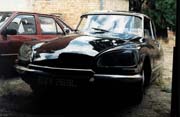Restoring Classic Cars A Classic Citroën
My interest in old cars started when I was about 14 years old. My father returned home with two old Minis that he had bought for twenty five pounds at the local farmers market. For a whole summer I tinkered and dismantled and tried to understand the workings of everything from the engine to the door locks. With some help, I finally rebuilt one working car from what had been previously two pieces of inanimate metalwork.




Turning the key and pressing the starter button and then hearing the engine start was quite a thrill. And then, under the watchful eye of my father, I drove slowly and carefully around the gravel driveway of our home. As I grew older my taste changed and the focus moved from not just wanting to understand how a car works, but how ingenuity and design play an important role in making a car more than a means of transport, but something from which many people gain enjoyment.
Most cars haven't changed too much fundamentally for the past 40 years. They are made up of three boxes: one at the front for the engine, one in the middle for the passengers, and one at the back for luggage. A wheel is placed at each corner and the three boxes sit on springs to make the ride a little more easy for the people inside. But some cars have shaken this simple idea and made some interesting and revolutionary changes. One of these cars is the Citroën DS. Even today, despite its age, it is sleek and strange and futuristic.
The DS was first released at the Paris motor show in 1955. The motoring world in Europe was astounded. The car was so full of new ideas that the competitors cars seemed archaic. On the first day of the show more than 12,000 orders were taken. Production of the same car continued until 1975 and even then the basic features of the car continued to turn heads.

My own car is a 1971 Citroën D Special. A right-hand drive model built for sale in Great Britain.
At rest the car sits low to the ground, a bit like a cat making ready to jump. Turn the key in the ignition and a few seconds after the engine starts, the front of the car slowly rises, followed soon after by the back; almost as you'd imagine a flying saucer. The car rises because instead of springs and fluid filled shock absorbers suspending the body at each wheel, there are four spheres filled with pressurized gas which become energized by the flow of hydraulic fluid from a high pressure pump. The system of pipes and pumps and valves controls not only the suspension of the car but also the steering and the brakes. This system was like nothing ever seen before when the car was first released.
Connections between each of the gas filled spheres keep the car level whatever the road surface or load that the car is carrying. The system gives a wonderfully smooth ride and for the uninitiated has a few tricks up it's sleeve. For instance, how about removing one of the wheels and driving on the remaining three, demonstrating the safety of self-leveling suspension should a tire blow out (although I wouldn't recommend this stunt). Or how about raising the level of the car by as much as 20cm by adjusting a lever beside the driver, allowing you to drive across the roughest of roads (or through the odd deep puddle of water). All very strange features for a car in the 1990's, let alone a car from 1955.
Next, take a look at where the brake pedal should be; instead of a pedal, there's a big black rubber mushroom, about the size of a tennis ball that has been cut in half. Now touch this carefully, because the brakes are very sensitive, and again for the unwary, a normal press of the pedal will send you quickly towards the steering wheel. The dome just needs to be touched gently to bring the car to a smooth halt, regardless of the weight or speed of the car. All those hydraulic systems thought up by the engineers at Citroën make this car quite extraordinary.
But beyond all of the engineering that goes unseen, the feature that attracted me in the first place was just the look of the car. With huge headlamps at the front that actually move so they point into the direction that you're steering, and sleek chromed lines that run from the roof towards the rear of the car, where they terminate in two orange signal lights. All in all a very unusual look for an "old" car. But that's why I like it...revolutionary engineering coupled with thoughtful design and some Gallic idiosyncrasy thrown in for good measure.
This content has been re-published with permission from SEED. Copyright © 2025 Schlumberger Excellence in Education Development (SEED), Inc.

